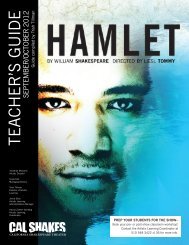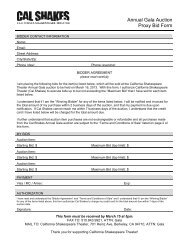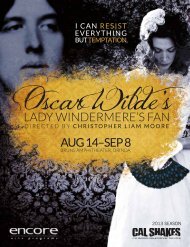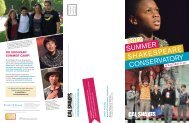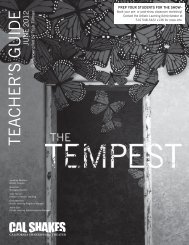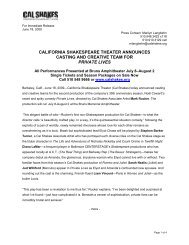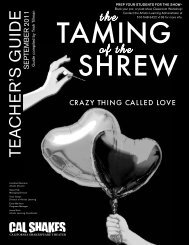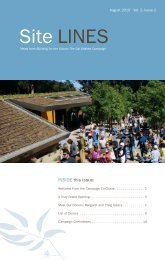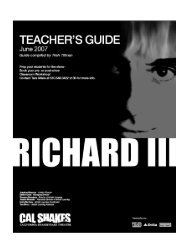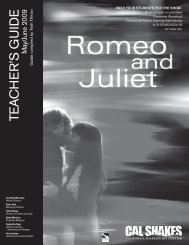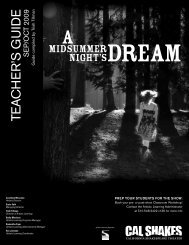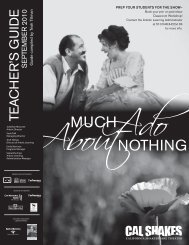Twelfth Night teacher's guide - California Shakespeare Theater
Twelfth Night teacher's guide - California Shakespeare Theater
Twelfth Night teacher's guide - California Shakespeare Theater
You also want an ePaper? Increase the reach of your titles
YUMPU automatically turns print PDFs into web optimized ePapers that Google loves.
CALIFORNIA CONTENT STANDARDS<br />
This <strong>guide</strong> was created as a supplement for teachers preparing students to see the Cal Shakes production of<br />
<strong>Twelfth</strong> <strong>Night</strong>. Worksheets are designed to be used individually or in conjunction with others throughout the <strong>guide</strong><br />
depending on time and focus. While we recognize that no aspect of this <strong>guide</strong> fully outlines a course for meeting<br />
certain standards, discussion questions and topics are devised to address certain aspects of <strong>California</strong> state<br />
content standards. Specific English, History and <strong>Theater</strong> standards are listed below.<br />
ENGLISH LANGUAGE STANDARDS<br />
GRADES K-8<br />
GRADE STANDARD READING<br />
6<br />
5<br />
4-8<br />
5-8<br />
4-8<br />
7<br />
5<br />
8<br />
7<br />
1.2<br />
1.5<br />
2.0<br />
2.3<br />
3.0<br />
3.3<br />
3.4<br />
3.4<br />
3.6<br />
Vocabulary and Concept Development<br />
Identify and interpret figurative language and words with multiple meanings<br />
Understand and explain the figurative and metaphorical use of words in context<br />
Comprehension and Analysis<br />
Generate & respond to essential questions; make predictions; compare information<br />
in age-appropriate text. Describe and connect essential ideas, arguments and<br />
perspectives.<br />
Discern, connect and clarify main ideas and concepts in texts, and identify and<br />
assess supporting evidence<br />
Literary Response and Analysis<br />
Read and respond to, increasingly complex literature. Distinguish between the<br />
structural features of the text and the literary terms or elements (theme, plot,<br />
setting, characters). Clarify ideas and connect them to other literary works.<br />
Analyze characterization as delineated through character’s thoughts words, speech<br />
patterns, and action; the narrator’s description; and the thoughts, words and<br />
actions of other characters<br />
Understand and recognize themes<br />
Analyze the relevance of the setting (place, time, customs) to the mood, tone and<br />
meaning of the text<br />
Contrast points of view (1st & 3rd person, limited and omniscient, subjective and<br />
objective) in narrative text and explain how they affect the overall theme of the work<br />
WRITING<br />
4 1.7<br />
Strategies<br />
Use various reference materials as writing aids<br />
4-8 2.2-2.5 Writing Applications<br />
Write responses to literature that demonstrate careful reading and understanding<br />
of the work. Draw inferences and support judgments.<br />
4-8 2.0<br />
Speaking Applications<br />
Using speaking strategies in section 1.0, above, students make narrative<br />
presentations, informational presentations, oral summaries, poems, soliloquies or<br />
dramatic dialogues that establish situation, plot, point of view and setting. Show<br />
rather than tell.<br />
8 2.2 Deliver oral responses to literature that interpret and provide insight that connect<br />
the students’ own responses to the writer’s techniques and specific textual<br />
references. Draw supported inferences about the effects of a work on the<br />
audience.<br />
PAGE 45



